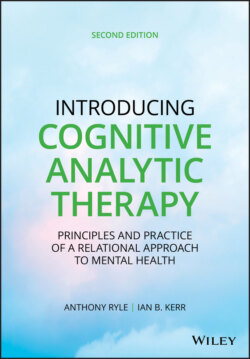Читать книгу Introducing Cognitive Analytic Therapy - Anthony Ryle - Страница 34
Mid Phase
ОглавлениеFollowing the more active and exploratory work of reformulation, the mid phase of therapy is characterized by a more open position in relation to the issues that the patient may spontaneously bring or which may gradually emerge. These may relate to problems in living in the “here and now” (for example, in relationships or at work), or may relate to historic issues from the past (for example, unresolved grief or losses, remembered experiences of severe relational adversity, or overt trauma and abuse). Some of these may possibly not have emerged in the early sessions and reformulations, or may have been provoked and facilitated by them. This phase represents an opportunity to discuss, process, and “work through” these various issues. During this phase, it is important that the therapist maintains focus and activity on the agreed aims of therapy (e.g., identifying and working on TPPs), but is also able to be receptively open, rather than always actively directive, and able to tolerate “not knowing” and uncertainty about what may or may not still emerge or require attention. This may also involve an ability to tolerate and facilitate productive (rather than persecutory) silences. For many trained in the more proactive, problem‐solving type approaches typical of most health services, this can be an unfamiliar and difficult capacity to acquire and may be a major challenge in training. This may also be a phase in which more “existential,” or for some patients, even “spiritual” issues arise and need to be responsively and respectfully addressed. Some of these may be related to the different (from the therapist) cultural or religious backgrounds of patients. These may play an important role in their lives and difficulties, and may occupy an important place on the “map.” All of these issues arising and brought by the patient, as well as inevitable ongoing “transference–counter‐transference” issues would be reflected upon jointly and always, ultimately, related back to the prior joint reformulations. This may greatly assist and enable “meaning‐making,” understanding, and processing in a non‐judgmental way, and, in the case of therapy‐threatening enactments, may help to identify and resolve them (see above and also Chapters 6, 10, and 11). This work may subsequently helpfully contribute to the further development and revision of the reformulations. These should always be seen as provisional “works in progress,” and as representing a formal expression of the dialog of therapy. As such they are understood to constitute “psychological tools.” Therapy during this phase may be productively enabled by and may require use of various adjuvant “techniques” depending on the issues arising, the skills of the therapist, and the context of therapy. This might include “empty chair” work, use of “no‐send” letters, creative or body therapies, or more formal trauma processing work. Some of these may require input from specialist colleagues either during or subsequent to a course of CAT. The phase of uncomplicated commitment to and hopefulness about therapy may fade out sometime subsequent to the reformulation phase and as the end of therapy becomes a more real prospect, and also as disappointments in the limits of what may be achieved begin to be thought about. It is important to identify and name both the early commitment and cooperation, and possible later emergence of negative feelings (including in relation to the therapist), and to link them to the reformulation. Failure to discuss and accept “transference” feelings and link them to the reformulation represents a missed opportunity and is likely to associated with dropping out and poor outcome. On the other hand, the matter‐of‐fact acceptance, description, but non‐reciprocation of hostility or emotional withdrawal—and equally of idealization—may be powerfully healing. Throughout this phase an eye should be kept on the fact that therapy will aim to be time‐limited, and this should be helpfully raised and noted in discussion at least intermittently, if not every session.
